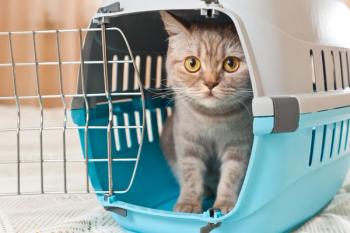
Porcine insulin zinc suspension in the management of feline diabetes mellitus (Sponsored by Intervet Schering-Plough Animal Health)
Vetsulin (porcine insulin zinc suspension) is approved by the FDA for reducing hyperglycemia and hyperglycemia-associated clinical signs in cats with diabetes mellitus.
Vetsulin (porcine insulin zinc suspension) is approved by the FDA for reducing hyperglycemia and hyperglycemia-associated clinical signs in cats with diabetes mellitus. Internationally, it was first approved for use in the early 1990s and is registered for dogs and cats as Caninsulin in more than 30 other countries.
Vetsulin is supplied as a sterile injectable suspension in multidose vials of either 2.5 ml or 10 ml of 40 U/ml (U-40) porcine insulin zinc suspension. Vials are supplied in cartons of one 10-ml vial and cartons containing ten 2.5-ml vials. Vetsulin should be administered using a U-40 insulin syringe. Use of a syringe other than a U-40 will result in incorrect dosing. Vetsulin should be kept refrigerated. It is good clinical practice to replace opened vials on a monthly basis.
Species differences in insulin
Pork insulin is a protein composed of 51 amino acids, arranged in two chains (an acidic A chain and a basic B chain) cross-linked by disulphide bridges.1 The amino acid sequence of insulin is highly conserved among vertebrates, with little variation in the amino acid sequence of the 21 amino acid A chain and the 30 amino acid B chain. Pork insulin has the same A-chain structure as canine and human insulin but differs slightly from feline insulin, as shown in Table 1. Pork insulin has the same B-chain structure as canine, feline, and bovine insulin but differs slightly from human insulin, as shown in Table 1.
Table 1. Amino acid comparison of insulin between selected species
Insulin from one mammal is biologically active in another. All mammalian insulins, irrespective of species origin, bind with a similar affinity to insulin receptors at the three sites of action—muscle, adipocyte, and hepatocyte—and initiate post receptor events in terms of autophosphorylation.2 Pork insulin is used effectively and safely in long-term human, canine, and feline cases.
Differences in amino acid structure of insulin from different species result in slightly different solubility, which in turn affects activity. For example, pork and beef zinc insulin crystals are more fat soluble than human zinc insulin crystals and, therefore, cross the blood-brain barrier more readily than human insulin. In practice, although patients on animal derived insulins may theoretically be aware of the onset of hypoglycemic episodes earlier, this difference is not completely clear.
Insulin pharmacokinetics and pharmacodynamics
The healthy pancreas secretes endogenous insulin as monomers (single molecules) from the beta cells of the islets of Langerhans. In contrast, exogenous insulin, for subcutaneous injection, consists of complex hexamers (complexes containing six subunits) that are broken down into monomers and dimers (molecules with two similar subunits) after subcutaneous administration. Monomers and dimers can be absorbed into the bloodstream more easily than hexamers. Different insulin products liberate monomers and dimers at different rates; however, once exogenous insulin has been absorbed from the subcutaneous injection site, the origin of the insulin has no effect on its ability to function in the body. Thus, it is the insulin formulation that determines the rate and extent of absorption, and the glycemic effects in the body. The rate at which the insulin is absorbed determines its duration of action. Rapid-acting insulins are absorbed quickly; however, they also have a short duration of action. In general, shorter-acting insulins (both rapid-acting and intermediate type insulins) are more consistently and completely absorbed, which gives more predictable glycemic effects, than long-acting insulins.
Vetsulin contains a combination of 30% amorphous and 70% crystalline zinc insulin, has a rapid onset of action, and has an intermediate duration of action following subcutaneous administration to cats. After subcutaneous injection, the amorphous component of Vetsulin releases monomers rapidly leading to a rapid onset of effect, whereas the crystalline component provides the intermediate duration of action due to a slower release of monomers.
In the bloodstream, insulin concentrations peak about two hours after Vetsulin is administered to cats with naturally occurring diabetes mellitus.3 Plasma insulin concentrations remain elevated for about nine to 12 hours. Vetsulin has an onset of action of less than two hours in diabetic cats with peak effects (blood glucose nadir) between 1.5 and eight hours after subcutaneous injection, although this varies between individuals.3-5 Based on blood glucose concentrations in diabetic cats, Vetsulin's duration of action is typically between eight and 12 hours.3,5,6
Safety
Vetsulin can be used in diabetic cats when dosed appropriately and accompanied by adequate monitoring of the disease process.3,4,6
Hypoglycemia
Regardless of the insulin origin or formulation used, any insulin dose above that required by the individual diabetic cat to control blood glucose concentrations will inevitably result in hypoglycemia. This can even occur at established doses if this is in excess of what the individual patient requires at that moment. This can be when glucose toxicity (as a result of prolonged hyperglycemia) is overcome, resulting in the individual patient requiring a lower dosage. A complicating factor, such as decreased appetite, is another possible cause of insulin excess; however, hypoglycemia in cats is usually associated with a high insulin dose.4,6 Clinical signs of hypoglycemia are not always obvious in cats, and may be restricted to lethargy. It is not uncommon for cats to show no clinical signs even when there is biochemical evidence of hypoglycemia.4,6
A dose greater than two units per cat twice a day should be used with caution, particularly in the first one to three weeks of treatment.4,6 Cats receiving insulin should be monitored regularly and hypoglycemia treated immediately, as addressed in Feline diabetes mellitus: Important communication points.
Immunogenicity
Beta cell and insulin antibodies appear to be involved in the pathogenesis of diabetes in dogs and people;7,8 but do not appear to be a feature in newly diagnosed and untreated diabetic cats.9,10 Although the structure of insulin is highly conserved, variations occur in up to four insulin amino acid residues between species. Interestingly, insulin antibodies have been shown to be specific for conserved regions, not variant residues.8
Immunoglobulin E antibodies mediate allergic reactions to insulin, although immunoglobulin G antibodies may participate.8 In people this can result in insulin allergy and insulin resistance. In human diabetics, the prevalence and titers of anti-insulin antibodies have decreased in the last three decades largely as a consequence of improvements in the purification of insulin preparations and the development of mono-component insulins.8 Reactions to insulin containing protamine may be caused by the protamine component—not by the insulin itself. Although allergic reactions to insulin are rare with purified insulins, Vetsulin should not be administered to cats that have a systemic allergy to pork or pork products. Interestingly, insulin antibodies appear to have a low prevalence in cats treated with insulin, irrespective of the source (recombinant human, mixed beef-pork, and pork insulin) of the insulin used for treatment.9,10 There also appears to be no clear association between the source of the insulin, the presence of insulin antibodies, and the occurrence of insulin resistance in insulin-treated diabetic cats. Further research is needed to investigate the clinical significance of insulin antibodies in cats treated with insulin.9,10
Goals of therapy
The goals of therapy are to eliminate the signs of diabetes mellitus (including polyuria and polydipsia) that occur secondary to hyperglycemia and glycosuria, maintain a healthy pet with a stable body weight, and avoid any diabetes-associated complications.11 The benefits of tight control of blood glucose must be balanced against the risk of life-threatening hypoglycemia.11
Dosing and regulation
Administration
Mix Vetsulin by gently rolling the vial before withdrawing the dose.5 Use a U-40 insulin syringe and inject subcutaneously 2 to 5 cm (3/4 to 2 inches) from the dorsal midline, varying from behind the scapulae to the mid-lumbar region and alternating sides.5
Recommended dosage
The initial goal is to establish significant control of the clinical signs resulting from hyperglycemia while avoiding hypoglycemia. For cats, the initial recommended dose is 1 to 2 U per injection given twice a day at approximately 12-hour intervals (Table 2). For cats fed twice a day, give the dose concurrently with or right after each meal.5
Table 2. Vetsulin therapy in diabetic cats
Efficacy
Achieving stability (resolution of clinical signs confirmed by biochemical evidence of well controlled diabetes) may take three to four months. Diabetic remission (the complete resolution of clinical and biochemical evidence of diabetes maintained after discontinuing insulin injections) can also develop during this period but may take much longer.3,4,6 In uncomplicated cases, insulin treatment of diabetic cats without dietary modification will result in stable diabetes in about two-thirds of diabetic cats and clinical remission in about one-fifth of patients.3,4,6,12 These numbers increase considerably if appropriate dietary management is initiated.13-15
Ongoing management
A satisfactory dose is achieved when clinical signs are eliminated or improved to the satisfaction of the owner, the cat is maintaining or attaining an appropriate weight, and physical examination findings, blood glucose and fructosamine values are acceptable. For cats fed ad libitum, no change in feeding schedule is needed. These cats should be re-evaluated at appropriate intervals and the dose adjusted based on clinical signs and biochemical confirmation of the level of glycemic control (e.g., blood glucose, fructosamine, urinalysis results). Fructosamine values, which reflect the average blood glucose concentration during the preceding two to three weeks, are often used to confirm that glycemic control is adequate. Fructosamine values above 550 μmol/L indicate that the diabetes is poorly controlled.11,16,17
The insulin dose may need to be adjusted further when the cat's diet, body weight, or concomitant medication changes or if the cat develops a concurrent infection, inflammation, neoplasia, other endocrine disorder, or other medical conditions. In diabetic cats, indicators of good glycemic control are the resolution of clinical signs, following a reduction in mean blood glucose concentration to below the renal threshold for glucose (around 300 mg/dl) combined with a blood glucose nadir between 80 and 200 mg/dl.11,16,17 In other words, a blood glucose curve that demonstrates that hyperglycemia is absent for the majority of the inter-dosing interval and hypoglycemia are avoided.
References
1. Sanger F. The chemistry of insulin. In: Nobel Lectures, Chemistry, 1942-1962. Amsterdam: Elsevier, 1964;544-556.
2. Abrams-OGG ACG. Chemistry and pharmacology of therapeutic insulin preparations, in Proceedings. 25th ACVIM Forum 2007. Available at:
3. Martin GJ, Rand JS. Pharmacology of a 40 IU/ml porcine lente insulin preparation in diabetic cats: findings during the first week and after 5 or 9 weeks of therapy. J Feline Med Surg 2001;3:23-30.
4. Martin GJ, Rand JS. Control of diabetes mellitus in cats with porcine insulin zinc suspension. Vet Rec 2007;161:88-94.
5. Vetsulin Freedom of Information Summary. NADA 141-236.
6. Michiels L, Reusch CE, Boari A, et al. Treatment of 46 cats with porcine lente insulin – a prospective, multicentre study. J Feline Med Surg 2008;10:in press.
7. Haines DM. A re-examination of islet cell cytoplasmic antibodies in diabetic dogs. Vet Immunol Immunopathol 1986;11:225-233.
8. Schnabel CA, Fineberg SE, Kim DD. Immunogenicity of xenopeptide hormone therapies. Peptides 2006;27:1902-1910.
9. Hoenig M, Reusch C, Peterson ME. Beta cell and insulin antibodies in treated and untreated diabetic cats. Vet Immunol Immunopathol 2000;77:93-102.
10. Adams JP, Catchpole B. Prevalence of anti-insulin antibodies in insulin-treated diabetic cats, in Proceedings. Br Sm Anim Vet Assoc Cong 2008;486-487.
11. Feldman EC, Nelson RW. Feline diabetes mellitus. In: Canine and Feline Endocrinology and Reproduction. 3rd ed. St Louis, MO: Saunders, 2004;539-579.
12. Goossens MM, Nelson RW, Feldman EC, et al. Response to insulin treatment and survival in 104 cats with diabetes mellitus (1985-1995). J Vet Intern Med 1998;12:1-6.
13. Bennett N, Greco DS, Peterson ME, et al. Comparison of a low carbohydrate-low fiber diet and a moderate carbohydrate-high fiber diet in the management of feline diabetes mellitus. J Feline Med Surg 2006;8:73-84.
14. Mazzaferro EM, Greco DS, Turner AS, et al. Treatment of feline diabetes mellitus using an alpha-glucosidase inhibitor and a low-carbohydrate diet. J Feline Med Surg 2003;5:183-189.
15. Weaver KE, Rozanski EA, Mahonay OM, et al. Use of glargine and lente insulins in cats with diabetes mellitus. J Vet Intern Med 2006;20:234–238.
16. Rand JS, Martin GJ. Management of feline diabetes mellitus. Vet Clin North Am Small Anim Pract 2001;31:881-913.
17. Martin GJ, Rand JS. Comparisons of different measurements for monitoring diabetic cats treated with porcine insulin zinc suspension. Vet Rec 2007;161:52-58.
Newsletter
From exam room tips to practice management insights, get trusted veterinary news delivered straight to your inbox—subscribe to dvm360.






